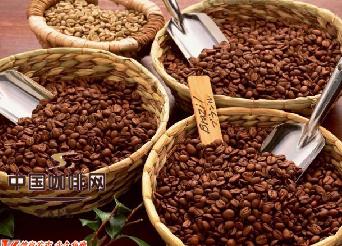Identification of freshness of coffee beans selection of coffee beans and discrimination of coffee beans

The selection of coffee beans and the discrimination of coffee beans
The freshness of coffee beans is the most important factor affecting the brewing quality of coffee, because the activity of coffee beans is hidden in its smell. Fresh coffee beans, like a can full of bubbles and full of taste, can smell a vibrant and pleasant aroma as soon as the bag is opened.
Smell
Put the coffee beans close to the nose and smell them deeply to see if you can clearly smell the aroma of the coffee beans. If so, it means the coffee beans are fresh enough. On the contrary, if the aroma is weak, or has begun to appear greasy, it means that the coffee beans are not fresh at all.
Look.
Fresh and good coffee beans are round in shape, big, fat and shiny, while on the contrary, they are broken and different in shape.
Peel off
Take a coffee bean and try to peel it off by hand. if the coffee bean is fresh enough, it should be easy to pluck away, and it will have a crisp sound and feeling. If the coffee beans are not fresh, you will find that you have to work hard to get rid of a bean.
Pressure
Before buying, put a bean in your mouth or hand and gently press it. The fresh bean has a crisp texture and a light, fragrant sound when it opens.
Pinch
It is best to squeeze it with your hands and feel whether it is solid, rather than buying coffee with a crispy shell.
Chew
When shopping, it is best to take one or two coffee beans in the mouth to chew, to clear sound (indicating that the coffee has not been damp), teeth and cheeks to stay fragrant is the top grade.
The purity of coffee beans
The expert candidate for coffee is not to look at the size of the particles, but to grab a handful of individual coffee beans, about dozens of them, to see if each coffee bean has the same color, grain size and shape, so as to avoid buying inferior products disguised as mixed beans. But if it is a comprehensive bean, size, color is different is a normal phenomenon.
Taste the coffee
1. Smell incense
A cup of fragrant coffee is brought to you. Please don't rush to drink it, but smell it first. Cover the coffee cup or test cup with your hand, take a deep breath and let the fragrance naturally pour into your nose. Do you smell the smell that fascinates you? It will directly affect your feeling of tasting coffee.
2. Watch the color
There are always subtle differences in the color of coffee, and the best coffee is dark brown rather than dark and bottomless.
3. Suck coffee loudly
After drinking boiled water and cleaning your mouth, you can suck and taste coffee loudly. It is not impolite to make a "strange noise" when sucking, the louder the better, it is the performance of an "expert". But you can't have too much coffee. Do you feel the subtle fragrance and thickness on your tongue when your whole mouth is filled with coffee? At this time, the coffee in your mouth had better be the optimal temperature of 61-62 degrees Celsius.
4. Smell the fragrance at the bottom of the cup
Drink the coffee as clean as possible, so that you can smell the coffee at the bottom of the cup, and each time there may be a different surprise. Sometimes it is fruity, sometimes it is floral, to name but a few, and it may be a mixed fragrance.
The best temperature for drinking coffee is 85 ℃-88 ℃. Because the texture of ordinary coffee is not stable, it is best to taste it while it is hot. In order not to reduce the taste of the coffee, soak the coffee cup in boiling water beforehand. The appropriate temperature for coffee is 83 ℃ at the moment of brewing, 80 ℃ when pouring into the cup, and 61 ℃-62 ℃ when it is in the mouth.
Generally speaking, tasting the coffee served by your host while it is hot is also the basic etiquette of drinking coffee. If a cup of high-quality coffee, after cooling, in addition to the aroma will be reduced, the taste performance is consistent with the hot, or even better.
Coffee beans contain about 5%, 8% sugar, most of which are converted to caramel after baking, which is the source of aroma and bitterness, leaving a little sweetness in the unconverted sugar; when baked, tannins are released and combined with caramel to produce a slightly bitter sweetness. Therefore, people's taste of coffee is generally bitter, sour, sweet, fragrant and astringent.
Drinking coffee is not like drinking or juice, a full cup of coffee, watching it will lose interest in drinking. Generally, it is only seven or eight minutes full for the right amount, moderate amount of coffee will not only stimulate the taste, after drinking it will not have a greasy feeling, but endless aftertaste. At the same time, the right amount of coffee can moderately promote the body to recover from fatigue and refresh the mind. Coffee has a strong and weak taste, so you can't drink several cups in a row like tea or cola, and the average amount of coffee is 80-100cc. Sometimes if you want to drink three or four cups in a row, you have to dilute the concentration of coffee, or add a lot of milk, so as not to cause nausea, and you might as well change more in the blending of sugar to make the coffee more delicious.
Important Notice :
前街咖啡 FrontStreet Coffee has moved to new addredd:
FrontStreet Coffee Address: 315,Donghua East Road,GuangZhou
Tel:020 38364473
- Prev

To distinguish coffee beans; to master a variety of knowledge; to distinguish coffee beans.
Recently, the key to distinguishing coffee beans is to respond to the needs of customers' gourmatism. the number of unroasted raw coffee bean stores is increasing all over the country. In the store, you can personally choose what you like from the raw coffee on display, and some stores can also bake it for you on the spot. In this way, you can taste the fried and fragrant coffee at home. Here, for each
- Next

Coffee varieties and characteristics Coffee cherry varieties
Coffee beans and characteristics of coffee cherry varieties: Arabilla species Libby species Romstar species Coffee beans varieties: Blue Mountain Mocha Brazil Santos Colombia Mandelin Guatemala Romstar complex Coffee trees are small shrubs growing in tropical highlands, their fruits are red or yellow, the inner fruit is what we call coffee beans. It is currently grown in 66 countries worldwide.
Related
- Guji coffee producing area of Guji, Ethiopia: Humbela, Shakiso, Wulaga
- What is the most expensive variety of Qiloso in BOP multi-variety group?
- How to store the coffee beans bought home?
- Why are Yemeni coffee beans so rare now?
- Ethiopian Sidamo all Red Fruit Sun Sun Santa Vini Coffee beans
- SOE is mostly sour? What does it mean? Is it a single bean? what's the difference between it and Italian blending?
- Is Italian coffee beans suitable for making hand-brewed coffee?
- How to choose coffee beans when making cold coffee? What kind of coffee beans are suitable for making cold coffee?
- Just entered the pit to make coffee, what kind of coffee beans should be chosen?
- Can only Japan buy real Blue Mountain Coffee? What are authentic Jamaican Blue Mountain coffee beans?

